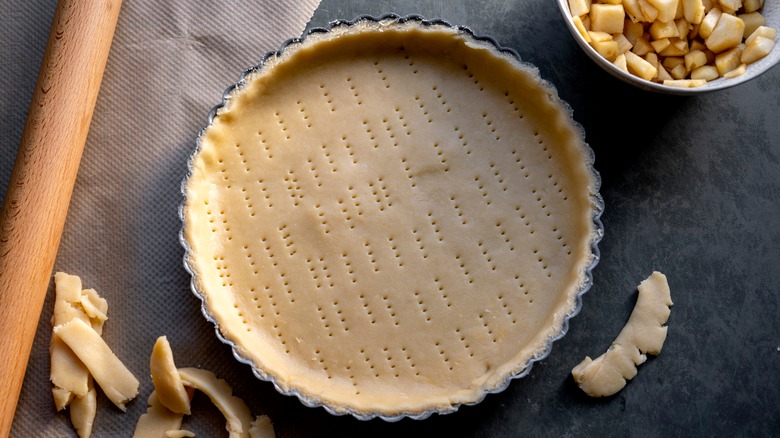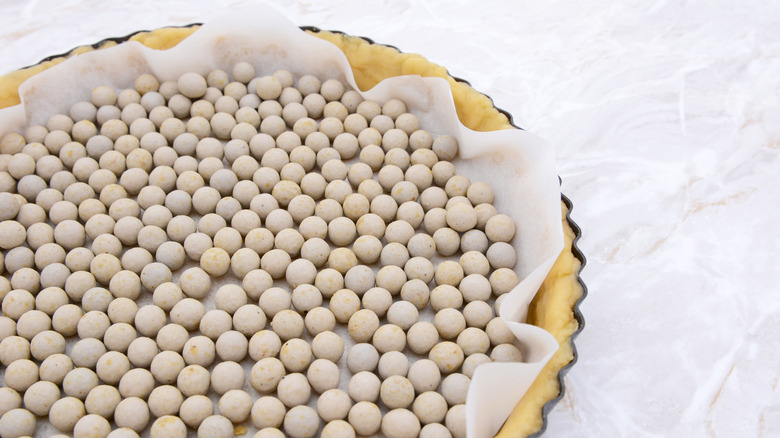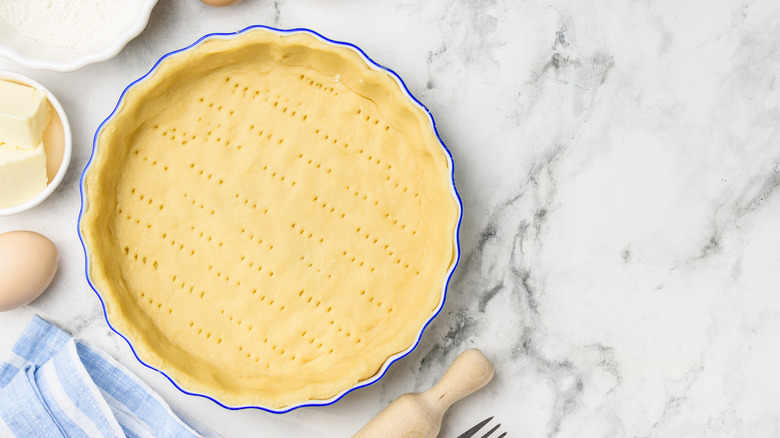Do You Really Need To Dock Pie Dough?
When first dipping your toes into homemade pies, you may have found that a fair number of recipes ask you to dock your pie dough before blind or par-baking it. If you're skeptical that the process of methodically poking holes into your pie crust would be necessary or effective in making a perfect pie crust, you'd technically be right. You don't really need to dock pie dough — but only if you're also taking other measures to keep the crust from losing its shape in the oven.
The truth is, docking serves a very important function in pre-baking pie crusts. By evenly perforating the floor of the crust, you're creating escape routes for any of the air or steam that may otherwise get trapped during the baking process, preventing moisture from potentially warping the dough with uneven air pockets or steamed-up soggy spots.
The most likely reason you see docking pop up as a common way of preparing a pie crust for pre-baking is that, relatively speaking, it's one of the more convenient and uncomplicated ways of doing so. The other most conventional way of reinforcing the structure of your crust during blind-baking is to hold it in shape by weighing it down. This is accomplished by covering the pie crust with a close-fitting layer of aluminum, then filling out the shape with oven-safe materials.
Weighing down your pie crust instead of docking
Notably, while you might see some recommendations for parchment or wax paper in addition to aluminum when it comes to lining your dough for pie weights, you should avoid anything that can potentially soak up the butter or lard that's essential for the flakiness of the crust. The kinds of pie weights you can use fall into two categories: Dedicated pie weights or certain kinds of pantry items with enough weight that won't catastrophically burn in the oven. Some of the most common suggestions include beans, rice, and plain granulated sugar; however, it's worth noting that sugar is the professional recommendation from chefs and baking companies. Mainly, it presents a more economical option than throwing out a full pie tin of charred beans or rice: The resulting toasted sugar can easily be reused for deeper flavor in other things like sugar cookies, simple syrup, or even just a simple upgrade in your next cup of tea or coffee.
Alternatively, you can invest in dedicated pie weights to skip any worries about using or disposing of baked sugar every time. There is a wide selection of pie weights available on the market, varying in affordability and overall efficacy depending on the type and materials used. While you can use ceramic, glass, or metal depending on your price range and needs, the overall consensus of reviews is that the beaded chain weights and single-piece weights aren't nearly as reliable or consistent, and should usually be avoided.
Reasons to dock or not to dock
All that said, it's probably obvious why docking is so popular in pie recipes. The entire process of carefully weighing down your dough without deforming the crust shape, then dealing with the aftermath — whether that's disposing of beans or sugar or putting pie weights in a safe place to cool — can be shortened down to poking the dough with a fork. However, the downside of this convenience is that your results may vary, and some find that docking isn't as consistent or reliable as pie weights.
That said, there's nothing stopping you from using both methods if you want to be extra sure. In fact, some swear by the method of using pie weights for the first section of blind-baking, then removing the weights and docking the crust after the sides have cooked a bit more. The rationale is to support the crust shape with the reliability of the pie weights during the initial blind-bake, then remove the weights so that the floor of the crust is exposed to the heat and more likely to cook through and develop a nicely browned surface. Of course, your mileage on this double method may vary depending on whether you're partially or fully blind-baking a crust before adding the filling.


